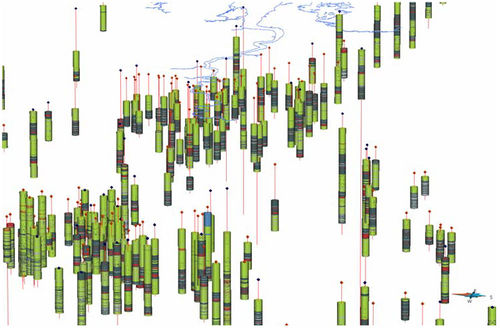OR/15/013 Model workflow: Difference between revisions
No edit summary |
m (Protected "OR/15/013 Model workflow" ([Edit=Allow only administrators] (indefinite) [Move=Allow only administrators] (indefinite)) [cascading]) |
(No difference)
| |
Revision as of 12:12, 7 May 2015
| Woods, M A, Newell, A J, Haslam, R, Farrant, A R and Smith, H. 2015. A physical property model of the Chalk of southern England. British Geological Survey Internal Report, OR/15/013. |
Boreholes (Figure 7), a terrain model and geological linework were loaded into SKUA-GOCAD as described in Section 5

Well sections were constructed to check the validity of marker picks and correlations between boreholes (Figure 8).

A structural framework for the model was established by building a series of cross-sections between boreholes (Figure 9). Cross-sections were mostly orientated perpendicular to the structural strike of the Chalk (Figure 10).

Polylines linking borehole markers and Z-attributed outcrop intersections were digitised for the four selected Chalk horizons.

For each horizon, a relatively coarse (5 km triangle size) triangulated surface was fitted to the digitised polylines from the cross-sections and to the well markers. The triangulated surfaces were locally densified in areas of tight curvature. The surfaces were not fitted directly to the Z- attributed DigMap-50 linework because this contains a large number of erroneous elevation values.

Horizons were initially produced as continuous, un-eroded surfaces and subsequently clipped to the digital terrain model to generate an approximation of the outcrop pattern (Figure 12).

Surfaces for the four horizons of interest and well markers were used as input data for the SKUA Structure and Stratigraphy Workflow - a step-by-step process of combining datasets to obtain a comprehensive 3D geological model (Figure 13). All input data and parameters for the model are given in a document link in Appendix 3.

Lithofacies property modelling of the Chalk was undertaken using the Reservoir Properties workflow in SKUA-GOCAD 2013.2. Appendix 4 provides comprehensive details on the inputs, parameters and methods applied in one modelling run. In summary, hard lithofacies data were transferred to the nearest grid cell in the model, upscaling where necessary by using the lithofacies closest to the cell centre. Given that cells ranged down to 0.5 m thick a good correspondence was achieved between input well data and the upscaled gridded data. Interpolation was undertaken sequentially in the three stratigraphic regions defined by Top Zig Zag Chalk, Top Lewes Nodular Chalk and strata above Top Lewes Nodular Chalk using indicator kriging with a nominal omnidirectional range of 150 km. This large variogram range produces what is effectively a well-to-well correlation of lithofacies, where the same lithofacies occurs within the same model layer. Given that most beds in the Chalk typically have lateral continuity over tens, or even hundreds of kilometres this approach seems reasonable as a starting point. ===

Multiple realisations of the model and the statistical evaluation of confidence have not been undertaken. Together with an increase in the sophistication of the geostatistical methods, these are areas for future work. At present we are satisfied that the general methodology is working based on the observations that the interpolated lithofacies mostly makes geological sense and there is a good correspondence in the observed and modelled facies proportions.
